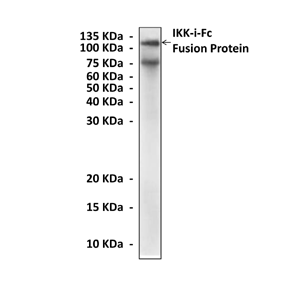Anti-IKK-i/IKBKE/IKK-ε: Mouse IKK-i/IKBKE/IKK-epsilon Antibody |
 |
BACKGROUND The NF-kappaB transcription factors are pivotal regulators of gene expression programs culminating in stress-like responses and the genesis of innate and acquired immunity. NF-kappaB activation is dependent on phosphorylation and subsequent degradation of IkappaB, a NF-kappaB inhibition. The IkappaB phosphorylation is mediated by a high molecular weight signalsome complex consisting of two IkappaB kinases (IKKalpha and IKKbeta, also known as IKK1/CHUK and IKK2, respectively) and a noncatalytic regulatory subunit (NEMO/NF-kappaB essential modulator, also known as IKKgamma/IKKAP-1/FIP-3). Two molecules of NEMO are believed to orchestrate the assembly of the IKKs into the high molecular weight signalsome complex partially by binding to specific carboxyl-terminally conserved residues of both IKKalpha and IKKbeta termed the NEMO binding domain (NBD). NEMO may also facilitate the recruitment of IkappaBalpha to the IKK complex. The two catalytic IKK subunits differentially respond via NEMO to an array of signal induced upstream kinase activities culminating in the coordinated phosphorylation of a pair of serines in their MAPK-like T activation loops.1 Activation of IKKbeta depends upon signal-induced phosphorylation of serines 177 and 181 in its T activation loop. However, unlike IKKbeta, a catalytic inactive mutant of IKKalpha with alanines replacing serines 176 and 180 in its analogous T activation loop (IKKalphaAA) had no demonstrable affect on the activity of IKK holocomplexes to induce IkappaBalpha degradation or NF-kappaB DNA binding activity in response to inflammatory cytokine stimuli in either transfected cells or fibroblasts derived from IKKalphaAA/AA knockin mice.2
Despite extensive sequence similarity, IKKalpha and IKKbeta have largely distinct functions, due to their different substrate specificities and modes of regulation. IKKbeta (and IKKgamma) are essential for rapid NF-kappaB activation by proinflammatory signaling cascades, such as those triggered by tumor necrosis factor alpha (TNFa) or lipopolysaccharide (LPS). In contrast, IKKalpha functions in the activation of a specific form of NF-kappaB in response to a subset of TNF family members and may also serve to attenuate IKKbeta-driven NF-kappaB activation. However, there was report that that IKKalpha is just as critical as IKKbeta and NEMO/IKKgamma for the global activation of NF-kappaB-dependent, TNFalpha- and IL-1-responsive genes.3 Moreover, IKKalpha is involved in keratinocyte differentiation, but this function is independent of its kinase activity.4
Two protein kinases, one called IKKepsilon or IKK-i and one variously named TBK1 (TANK-binding kinase), NAK (NF-kappaB -activated kinase), or T2K (TRAF2-associated kinase), were identified that exhibit structural similarity to IKKalpha and IKKbeta. It was shown that IKK-i is essential for regulating antiviral signaling pathways and may act as an IkappaB kinase in the immune system. IKK-i has also been identified as a breast cancer oncogene and is amplified and overexpressed in over 30% of breast carcinomas and breast cancer cell lines.5
REFERENCES
1. Karin, M.: Oncogene 18:6867-74, 1999
2. Cao Y. et al: Cell 107:763-75, 2001
3. Li,X. et al: J. Biol. Chem. 277:45129-40, 2002
4. Liu, B. et al: Cell Cycle 8:527-31, 2009
5. Huber, M.A. et al: J. Clin. Invest. 114:569-81, 2004
2. Cao Y. et al: Cell 107:763-75, 2001
3. Li,X. et al: J. Biol. Chem. 277:45129-40, 2002
4. Liu, B. et al: Cell Cycle 8:527-31, 2009
5. Huber, M.A. et al: J. Clin. Invest. 114:569-81, 2004
Products are for research use only. They are not intended for human, animal, or diagnostic applications.
Параметры
Cat.No.: | CP10132 |
Antigen: | Purified recombinant human IKK-i expressed in E. coli. |
Isotype: | Mouse IgG |
Species & predicted species cross- reactivity ( ): | Human |
Applications & Suggested starting dilutions:* | WB 1:1000 IP n/d IHC n/d ICC n/d FACS n/d |
Predicted Molecular Weight of protein: | 82 kDa |
Specificity/Sensitivity: | Detects endogenous IKK-i proteins without cross-reactivity with other family members. |
Storage: | Store at -20°C, 4°C for frequent use. Avoid repeated freeze-thaw cycles. |
*Optimal working dilutions must be determined by end user.
Документы
Информация представлена исключительно в ознакомительных целях и ни при каких условиях не является публичной офертой








